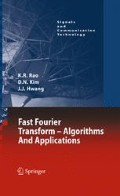Abstract
For signals consisting of a number of frequency components, the Fourier transform 4 (FT) effectively reveals their frequency contents and is generally able to represent 5 the signals with an acceptable resolution divided by equal bandwidth in the 6 frequency domain. The discrete Fourier transform (DFT) is an important tool for 7 digital signal processing, in which the N-point DFT of a length-N sequence is given 8 by the frequency samples at N-uniformly spaced points [W23]. It has been widely 9 applied in solving both time-domain and frequency-domain problems, signal anal- 10 ysis/synthesis, detection/estimation, and data compression [B6].
Access this chapter
Tax calculation will be finalised at checkout
Purchases are for personal use only
References
A.K. Jain, Fundamentals of Digital Image Processing (Prentice-Hall, Englewood Cliffs, NJ, 1989)
A.V. Oppenheim, R.W. Schafer, J.R. Buck, Discrete-Time Signal Processing, 2nd edn. (Prentice-Hall, Upper Saddle River, NJ, 1998)
S.J. Leon, Linear Algebra with Applications, 6th edn. (Prentice-Hall, Upper Saddle River, NJ, 2006)
L.C. Ludeman, Random Processes: Filtering, Estimation and Detection (Wiley, Hoboken, NJ, 2003)
G. Goertzel, An algorithm for the evaluation of finite trigonometric series. Am. Mathem. Monthly 65, 34–35 (Jan. 1958)
J.W. Cooley, J.W. Tukey, An algorithm for the machine calculation of complex Fourier series. Math. Comput. 19, 297–301 (Apr. 1965)
A. Ben-Israel, T.N.E. Greville, Generalized Inverses: Theory and Applications (Wiley, New York, 1977)
K. Atkinson, An Introduction to Numerical Analysis (Wiley, New York, 1978)
M. Marcus and H. Minc, A Survey of Matrix Theory and Matrix Inequalities. New York: Dover, pp. 15−16, 1992
M. Lightstone et al., Efficient frequency-sampling design of one- and two-dimensional FIR filters using structural subband decomposition. IEEE Trans. Circuits Syst. II 41, 189–201 (Mar. 1994)
S. Bagchi, S.K. Mitra, An efficient algorithm for DTMF decoding using the subband NDFT. IEEE ISCAS 3, 1936–1939 (Apr./May 1995)
S. Bagchi, S.K. Mitra, The nonuniform discrete Fourier transform and its applications in filter design: Part I – 1-D. IEEE Trans. Circ. Sys. II Analog Digital SP 43, 422–433 (June 1996)
S. Carrato, G. Ramponi, S. Marsi, A simple edge-sensitive image interpolation filter, in IEEE ICIP, vol. 3, Lausanne, Switzerland, Sept. 1996, pp. 711–714
S. Bagchi, S.K. Mitra, The Nonuniform Discrete Fourier Transform and Its Applications in Signal Processing (Kluwer, Norwell, MA, 1999)
A.J.W. Duijndam, M.A. Schonewille, Nonuniform fast Fourier transform. Geophysics 64, 539–551 (Mar./Apr. 1999)
D. Potts, G. Steidl, M. Tasche, Fast Fourier transforms for nonequispaced data: A tutorial, in Modern Sampling Theory: Mathematics and Applications, ed. by J.J. Benedetto, P.J.S.G. Ferreira (Birkhäuser, Boston, MA, 2001), pp. 247–270
J.A. Fessler, B.P. Sutton, Nonuniform fast Fourier transforms using min-max interpolation. IEEE Trans. SP 51, 560–574 (Feb. 2003)
K. Fourmont, “Non-equispaced fast Fourier transforms with applications to tomography,” J. Fourier Anal. Appl., vol. 9, pp. 431–450, Sept. 2003
K.-Y. Su, J.-T. Kuo, Application of two-dimensional nonuniform fast Fourier transform (2-D NUFFT) technique to analysis of shielded microstrip circuits. IEEE Trans. Microw. Theory Techniq. 53, 993–999 (Mar. 2005)
J.J. Hwang et al., Nonuniform DFT based on nonequispaced sampling. WSEAS Trans. Inform. Sci. Appl. 2, 1403–1408 (Sept. 2005)
J.O. Smith III, Mathematics of the Discrete Fourier Transform (DFT) with Audio Applications, 2nd edn (W3K Publishing, 2007), available: http://ccrma.stanford.edu/~jos/mdft/mdft.html
Author information
Authors and Affiliations
Corresponding author
Rights and permissions
Copyright information
© 2010 Springer Science+Business Media B.V.
About this chapter
Cite this chapter
Rao, K.R., Kim, D.N., Hwang, J.J. (2010). Nonuniform DFT. In: Fast Fourier Transform - Algorithms and Applications. Signals and Communication Technology. Springer, Dordrecht. https://doi.org/10.1007/978-1-4020-6629-0_7
Download citation
DOI: https://doi.org/10.1007/978-1-4020-6629-0_7
Published:
Publisher Name: Springer, Dordrecht
Print ISBN: 978-1-4020-6628-3
Online ISBN: 978-1-4020-6629-0
eBook Packages: EngineeringEngineering (R0)

